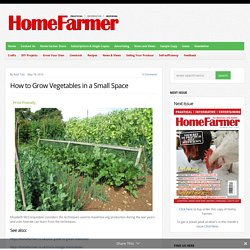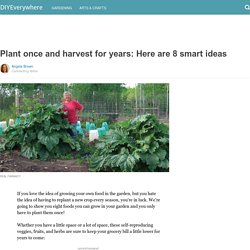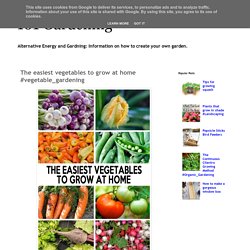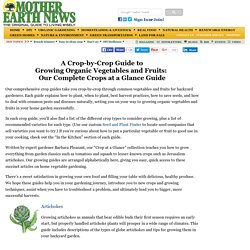

7 Fall Vegetables You Should Grow. Fall vegetables offer a bounty of color, flavor, and nutrition.

The vegetables that are in season in the fall include pumpkins and squashes of all sorts (my favorites are kabocha, butternut, and red kuri), cauliflower, all the potatoes, and hearty greens like collards and kale, which do quite well in cooler weather. Other autumn favorites include carrots, cabbage, Brussels sprouts, and gorgeous beets in all colors. For all veggies, growing time depends on your local climate. Better Homes and Gardens reminds us that we need to plant our fall gardens based on the expected date of the first frost and then count backward based on the vegetable you want to plant. Add about two weeks extra to account for the decreased daylight hours. Lettuce Lettuce can be planted 4-8 weeks before the first frost and sometimes even into frosty weather if you have cold frames. Collards, Cabbage, and Kale. How to Grow Vegetables in a Small Space - Home Farmer. Elizabeth McCorquodale considers the techniques used to maximise veg production during the war years and asks how we can learn from the techniques See also: Nobody starved in Britain during the First World War due to lack of supplies, and this was largely down to the government encouraging the gardeners and householders of the country to ‘Plant Victory Gardens’, a movement that was followed up with emphasis twenty years later in the Second World War campaign, ‘Dig for Victory’.

Two messages came across loud and clear: turn over land to food production, and use that land wisely. Lawns and back gardens were dug up and planted with vegetables, and parks and public spaces were commandeered to be turned over to feed the nation. Posters urged gardeners to follow their summer vegetables with winter crops and to make the most of every bit of space. Maximising a small space for veg production.
Beans were just one of many starchy crops sown for winter use. Catch-cropping A catch-crop of carrots. How to Plan a Bigger, Better Garden - Easy Vegetable Garden Planning. Plant once and harvest for years: Here are 8 smart ideas. If you love the idea of growing your own food in the garden, but you hate the idea of having to replant a new crop every season, you're in luck.

We're going to show you eight foods you can grow in your garden and you only have to plant them once! Whether you have a little space or a lot of space, these self-reproducing veggies, fruits, and herbs are sure to keep your grocery bill a little lower for years to come: 1. Plant once and harvest for years: Here are 8 smart ideas. Grönsaker, Trädgårdsland och Trädgårdsskötsel. 101 Gardening: The easiest vegetables to grow at home #vegetable_gardening. 1.

Carrots: Find a plot of soil (or a deep pot) that is free from rocks and deep enough to handle this root vegetable. Rocky soil can result in crooked carrots that, while perfectly edible are not the most aesthetically pleasing. Carrots are ready for harvest when their tops breach the soil line. Scarlet Nantes, Danvers Half Long and Sweet Treat are three varieties to try. 2. 3. 4. 5. 6. 7. 8. 9. 10. 0 3 0Google +9 20.
Home and Garden DIY Ideas, Photos and Answers.
Easy & Fast-Growing. Perennial vegetables. Container Vegetables. Layouts. A Crop-by-Crop Guide to Growing Organic Vegetables and Fruits: Our Complete ‘Crop at a Glance’ Collection. Our comprehensive crop guides take you crop-by-crop through common vegetables and fruits for backyard gardeners.

Each guide explains how to plant, when to plant, best harvest practices, how to save seeds, and how to deal with common pests and diseases naturally, setting you on your way to growing organic vegetables and fruits in your home garden successfully. In each crop guide, you’ll also find a list of the different crop types to consider growing, plus a list of recommended varieties for each type. (Use our custom Seed and Plant Finder to locate seed companies that sell varieties you want to try.) If you’re curious about how to put a particular vegetable or fruit to good use in your cooking, check out the “In the Kitchen” section of each guide. Written by expert gardener Barbara Pleasant, our “Crop at a Glance” collection teaches you how to grow everything from garden classics such as tomatoes and squash to lesser-known crops such as Jerusalem artichokes.
Artichokes Asian Greens Beans.